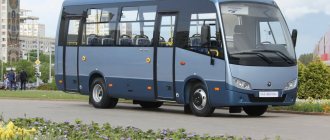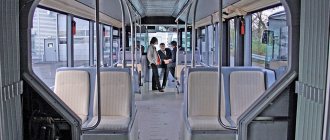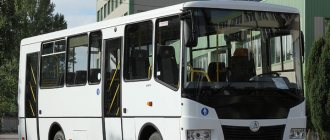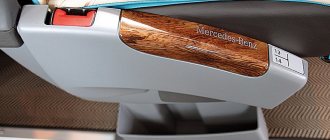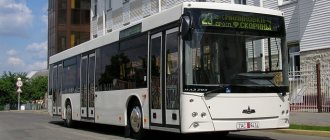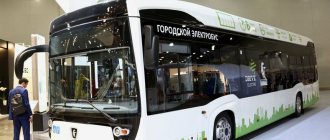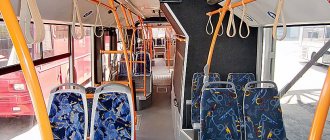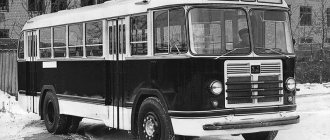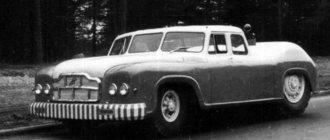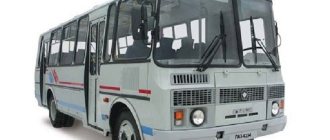Mediators between earth and sky (Part 2)
Oleg Bodnya Photo by the author, Maxim Holbraicht, Oleg Ziminov, Evgeny Leontyev, Andrey Mikhailov, Artyom Mikhailov, Alexey Rudzyak, Ivan Chernysh, from the archives of the press services of the Kiev airport and the Busworld Europe exhibition, manufacturing plants and their dealers
Part 1 Part 2
History of creation
The Minsk residents released their first platform bus, the MAZ-171, almost “low-key.” Nobody produced such equipment in the post-Soviet space, but there was a need for it : airports in large cities were developing, receiving international certificates, and it was necessary to comply with requirements related to passenger transportation, among other things. So the Minsk Automobile Plant came to the rescue: it came up with a bus from scratch , unlike any other model produced at the enterprise. And the 171st became successful.
Platform bus MAZ-171. Photo RusbusinessAuto
He was always special. The proximity to airplanes probably has an effect. The platform bus is very different from any other model that can be found on the roads. Wide, long, with doors on both sides: 171 has become one of the symbols of the National Airport.
Platform buses at that time were produced only by foreign companies. The Belarusian enterprise had experience in international cooperation : the first Minsk city buses began with a contract signed with the German Neoplan. But the Minsk residents decided to make their own platform bus.
To those who came to the airport in those years, it seemed that this was the bus of the future . Unusually wide, ultra-low-floor, ultra-spacious - it’s clear that it’s not for city streets, but it looked impressive .
For a long time, the 171st was the link between earth and sky: it transported passengers to the plane's ramp and picked up those who returned to the ground. A workhorse, albeit a very futuristic one. Years passed, planes took off and landed, the future gradually took shape into the present.
At the end of 2022, the Minsk Automobile Plant began to work closely on developing a new generation model.
It was decided to stick to the dimensions of the 171st . The main quality of a platform bus is its high passenger capacity, which is why the models are so wide.
An interesting detail: the type of buses at airports will be partly decided by the railway workers. One way or another, equipment has to be transported on railway platforms, and for such cargo there are width restrictions.
Characteristics of the new model:
- length - 14.48 m;
- width - 3.19 m;
- maximum height (including air conditioning) - 3.25 m;
- passenger capacity - up to 112 people.
This bus is significantly larger than any other designed for urban transportation.
European approach
Modern buses for passenger airports have an original appearance both due to the engineering solutions we have already mentioned, due to the specific use of “approns”, and due to the use of the latest structural materials, which make it possible to lighten the body and make its appearance memorable.
Panoramic glazing, plastic panels of complex shapes and fancy optics work wonders. In addition, do not forget that apron vehicles do not travel outside airports, which means they are not afraid of accidents, and the body can be made lighter, with additional glazing, which is what manufacturers of such equipment use. Technical characteristics of some models of platform buses
| APPA-4* | MAZ-171 | NefAZ-5299-40-52 | Navy Neoport | Cobus 3000 | Neoplan Airliner N9122L * | TAM Vivair 104WL | |
| Length, mm | 14 100 | 14 400 | 12 155 | 14 000 | 13 920 | 14 720 | 14 720 |
| Width, mm | 2 730 | 3 150 | 2 500 | 3 000 | 3 000 | 3 170 | 3 170 |
| Passenger capacity, persons ** | 100–120 | 99–122 | 110 | 96 | 110 | 136 | 104–144 |
| Number of seats, pcs. | 16–20 | 6 | 12 | 12 | 14 | 6 | 14 |
| Total weight, kg | 17 850 | 21 420 | 18 000 | 21 000 | 20 400 | 23 690 | No data |
| Engine | – | Deutz BF4M1013 | Cummins ISB6.7e | Cummins ISB4.5 | Mercedes-Benz OM904LA | MAN D0836 LOH | MAN D0836 LOH |
| Engine power, hp | 150 | 170 | 238 | 185 | 152 | 240 | 240–250 |
| Transmission | – | GMP ZF | GMP ZF | GMP Allison | GMP Allison | GMP Voith | GMP Voith, ZF |
* Model discontinued.
**Official data on vehicle passenger capacity are provided, calculated using various cabin filling standards (from 4 to 8 people/m2). No more than 20 companies are involved in the development and production of airport buses, and this process is not widespread, but isolated. The reasons are clear: the sales market is relatively small, additional restrictions are introduced by the high cost of products and their long life cycle due to “greenhouse” operating conditions.
The market leader is a small company Cobus from Wiesbaden (Germany). It is the only manufacturer specializing exclusively in apron machines. The company produces new equipment at factories in Portugal, Switzerland and Germany, and also repairs and resells used buses. The modern Cobus product line includes buses of the 2700S, 2700 and 3000 models, designed to carry 77, 96 and 110 passengers. The digital designation of the model corresponds to the width of the body in millimeters.
The company's new product is the e.Cobus airfield electric bus based on the Cobus 3000 model. The electric bus uses lithium-titanate batteries as a power source; charging time when connected by cable to a special station is from 1 to 2 hours. Battery life is at least 12 years.
Until recently, the second (and a little earlier – the first) company in importance was Neoplan. Until now, buses of this brand operate at many airports around the world, however, the new specialized Neoplan equipment is no longer produced. Now the range of Neoplan models has been reduced to three families of tourist buses.
However, the potential inherent in the latest model of the Neoplan airport bus turned out to be so great that other companies bought the license for its production. The creation of new “Neoplanes” was mastered in Greece (ΕΛΒΟ Hellenic Vehicle
Industry SA), Iran (Iran Khodro), as well as Viseon Bus GmbH (Germany, liquidated in 2014) and TAM-Europe (Slovenia). New machines of the Neoplan Airliner series began to be produced en masse under the Youngman brand - we will talk about this Chinese manufacturer a little later.
The Slovenians, by the way, did not abandon their plans to manufacture platform buses and created their own TAM Vivair line, which includes three models that differ in length and width - 60S, 88W and 104WL. The digital indices of the models are again “telling”: they indicate the lower threshold of vehicle passenger capacity. Several Slovenian aprons are already serving the airports of our western neighbors. We are talking about the flight harbors of Kyiv and Kharkov.
The Belgian company Van Hool periodically addresses the topic of airfield transport. The Belgians produce platform buses exclusively on special order. The last known case was in 2012, when three ultra-capacity Van Hool AP2375 shuttle buses were created for Algiers Airport. Check out the scope: length 14.64 m, width 3.75 m, 6 automatic double-leaf doors (two pairs of doors on the right and left, one more in front and rear), total passenger capacity - 160 people, seating - 14.
Detailed description and device
Body. Taking into account the wishes of the operators, the supporting frame, welded from steel profiles and rectangular pipes , is lined with galvanized sheet. Fiberglass was actively used in the production of the body : a fairly durable material that is also easy to work with.
Bus MAZ-271, general view. Photo MAZ
What immediately catches your eye: there are no rear-view mirrors . More precisely, they are hidden in the driver's cabin - not mirrors, but screens that imitate them. The image is displayed from cameras: there are two of them installed on each side.
The body of the bus resembles the shape of a pencil - the nose seems to taper. This is purely a design decision. For this reason, the outside mirrors would have to be moved very far away for the driver to be able to see anything in them. Another solution has been found - video mirrors.
Platform buses have doors on both sides . This is necessary so that you can approach both the airport apron and the plane from any direction. MAZ has three double doors, which should speed up the boarding and disembarkation of passengers. Airport transport has its own specifics: everyone either gets in or gets out - no one will disturb anyone, as is the case in public transport.
From an engineering point of view, this arrangement of doors (as in a subway car) has its own specifics. On the one hand, cutting out a doorway in the body is not difficult. On the other hand, it is necessary to make changes to the overall design, since a solid side is able to carry a larger load.
One of the doorways has a special ladder for people with disabilities . At the customer's request, more such drains can be installed. In addition, the model is equipped with a kneeling system - this is when the bus tilts for the convenience of passengers when boarding and disembarking.
LED optics are presented even in the basic model.
There is also a trick with the exhaust system. It is located in the front and extends to both sides of the bus. When the doors open, the computer blocks the exhaust in the appropriate direction so that people do not breathe the gases.
The coloring of this particular model is made in classic colors : black and white. But it all depends on the wishes of the customer. This issue, by the way, is complex and is often resolved at a high level. There is a legend that once upon a time, at the instigation of the chief architect of Minsk, buses in the capital were green. This is despite the fact that two different shades were used to paint the upper and main parts of the body. Then they said in the spirit of Henry Ford: a Minsk bus can be any color, but provided that this color is green. Recently, preferences have changed, and the Minsk bus has become yellow.
Interior of the MAZ-271 bus. Photo MAZ
But an airport is always its own story. One can only guess what bold experiments customers will undertake. At least we have already seen purple buses at the National Airport.
Salon. The priority is passenger capacity. On a bus like this you feel it like nowhere else. It’s not that there’s nothing superfluous here, there’s practically nothing here at all. An empty and fairly large room - this is what it looks like from the inside. And thanks to the huge glass area, it seems that the inside is even more spacious than it actually is.
It is also worth noting that to reduce the size of the wheel arches in the bus interior, wheels of different sizes are used: in the front - single-pitch, with 385/65 R22.5 tires, in the rear - gable, with dimensions 265/70 R19.5.
Eight passenger seats - that's basically it. At the customer's request, additional seats can be installed : for example, in this particular model, six more seats are provided near the partition of the driver's cabin. Total fourteen. You need to understand that a trip on such a bus from the airport passenger terminal to the plane will not take much time, and passengers are unlikely to try to sit down. At the same time, a large number of seats would take up space in the cabin. However, as the company emphasizes, the issue of layout is always discussed with the customer.
Another engineering solution that differs from the 171st model is the location of the door levers . Previously, they were located in the passenger compartment (like in public transport), but now they are placed under the base of the bus.
The driver can see what is happening in the cabin using an installed CCTV camera . Thanks to the increased glass area, the inside has become lighter, and in the dark, LED backlighting is responsible for lighting.
Even the basic model has a King Clima air conditioner with a power of 40 kW, which works both for interior cooling and heating. The air conditioners are equipped with an improved air duct design for uniform air distribution throughout the cabin. There are no windows, they are of no use at such short distances, but there will be no questions with those who do not trust technology and do not listen to the rule “Do not open windows when the air conditioner is running.”
Heaters (convectors) and air curtains are also responsible for heating the interior during the cold period . Powerful fans are installed , which turn on when the doors are opened and either allow you to keep warm air inside the cabin at low temperatures outside, or, conversely, prevent the heat from penetrating.
Driver's cabin of the MAZ-271 bus. Photo MAZ
Using the example of the 303rd model, the Minsk Automobile Plant showed that, if necessary, it can equip its buses with sockets and USB connectors, but there is nothing of the kind on the platform bus. A purely practical approach: hardly anyone would charge their phone during a 5-minute trip to the plane.
Driver's cabin. Have you ever wondered why the driver of the platform bus has such a spacious cabin? On city buses it is much more modest, but here there is a whole room.
The driver's cabin is essentially combined with the engine compartment. In such buses the engine and all systems are installed . Everything else is an empty cabin for passengers. The drive, by the way, is also on the front wheels.
In the driver's cabin there are two seats separated by a huge tunnel : this is a standard layout for such cars. On the “lid” itself there are stampings of various sizes for small items.
The driver's seat is equipped with a safety steering column , which is adjustable in angle and height and even has an anti-theft function. The chair is equipped with air suspension and has cushion adjustments in height, longitudinal position, tilt angle, as well as additional backrest adjustment. The windshield is multilayer, glare-free.
Engine. The 171st MAZs were equipped with 4-cylinder Deutz engines , and the second generation buses received 6-cylinder in-line power units Daimler OM926LA.V/6 with turbocharging . Power - 238 hp. s., environmental class - Euro-5. The new MAZ is equipped with a 6-speed Allison-T270 automatic transmission.
An optional centralized lubrication system is installed on buses: you press a button and the required amount of substance is supplied to all consumers where grease nipples are located.
An interesting point: the exhaust system of the bus is located in the niches of the front wheel arches on both sides, and depending on which side passengers disembark from, the system automatically closes the corresponding pipe, redirecting all exhaust to the opposite side.
Features and advantages of MAZ 171
The MAZ 171 bus was developed on the basis of a low-floor vehicle with index 103. It is designed to transport passengers (up to 122) to the aircraft ramp.
In fact, this is a successful platform adaptation of a city bus. The salon has 3 doors on each side. There are no steps: the floor is separated from the road by only 30 cm. Among the advantages of the MAZ-171:
- successful technical configuration;
- Automatic transmission, front-wheel drive, powerful engine (Euro 3);
- ergonomic driver's seat;
- availability of places for disabled people;
- safety of boarding/disembarking.
The MAZ-171 bus meets in all respects the modern requirements of ICAO class apron vehicles.
Basic information, characteristics
- Manufacturer/manufacturer where the equipment is produced/manufactured. OJSC Minsk Automobile Plant (MAZ) is a Soviet and Belarusian automobile manufacturing company specializing in the production of heavy-duty automobiles, as well as buses, trolleybuses and trailers.
- Purpose. Special, platform.
- Class. Especially big.
- Body type. Load-bearing, low-floor.
Engine/powertrain characteristics
- Model. Mercedes-Benz OM 926 LA.
- Type. Diesel.
- Number and arrangement of cylinders. 6 row.
- Environmental safety standards. Euro-5.
- Working volume, l. 7,2.
- Engine power, kW (hp)/min. 240 (326)
- Maximum torque, Nm/min. 1600.
- Engine location. Front.
- Checkpoint. Automatic 6-speed Allison T270.
- Front-rear axle suspension. Dependent, electronic-pneumatic-Dependent, electronic-pneumatic.
Bus MAZ-103 for urban passenger transportation
Its overall dimensions are:
- Length 11.985 m.
- Width 2.5 m.
- Height 2.838 m.
The salon is equipped with three doors 1.2 m wide, and with a number of seats that ranges from 21 to 28, it can accommodate 70 – 110 passengers. The height of the cabin is 2.37 m, which makes the trip comfortable even for people whose height is more than 190 cm, and the width of the passage between the seats is 73 cm. The heating is liquid and completely independent of the bus power unit.
The line of power units that are installed on buses consists of three engines. These are Mercedes-Benz OM 906LA and DEUTZ BF6M.1013EC - foreign-made four-cylinder in-line diesel power units, which are paired with ZF and Voith Diwa automatic transmissions. As well as the domestic diesel engine MMZ D-260.5, which is installed in tandem with a five-speed manual gearbox Praga 5PS 114.57.
Equipment
- Information system
- Imported tires
- Anti-vandal passenger seats SNLK – 939, 8 pcs.
- Seat for driver and crew member with seat belt manufactured by JSC RIAT
- Pneumatic door control drives LLC "First Five-Year Plan"
- Interior air conditioner SDDR-06 manufactured by Guchen
- Driver air conditioner EP-02 manufactured by Guchen
- Air curtain system manufactured by Sanz CLIMA, integrated into the bus heating system
- Multiplex bus electrical equipment control system
- Independent air heater for driver's cab
- Body paint color RAL 9016
High capacity for urban routes
The MAZ-105 bus is an excellent model of passenger transport with particularly large capacity for urban transportation. This bus, thanks to its design features and the articulation of two interiors together, reaches almost 18 meters in length and is equipped with 4 doors. Their size is considered standard for vehicles intended for regular trips around the city and is 1.2 m.
Like the two models described above, the MAZ-105 bus is low-floor, as evidenced by the height of the first step in relation to the ground, which is 34.5 centimeters. This figure is further proof that all developments were aimed at passenger comfort, and getting into the vehicle will not be difficult even for people of advanced age or short stature.
The power unit installed on this model is Mercedes-Benz OM 906LA. It is paired with an automatic transmission. The maximum permissible speed is 70 km/h.
Advantages
- The only one in its class among manufacturers in the CIS countries
- Compliance with international requirements according to IATA Airport Handling Manual
- Optimal coordination of the main components
- Units from the world's leading manufacturers
- With comparable characteristics, much cheaper than European analogues
Seats in the MAZ-271 cabin. Photo MAZ
Peculiarities
New level of comfort in the cabin:
- The useful area of the cabin for passengers has been increased. There are 8 or 14 seats available.
- Improved lighting. “Light lines” of modern LED lighting have been installed.
- Conditions for passenger safety have been improved. The wheel arches have been reduced, the lower door arms go under the floor, and information systems have been installed.
- Improved microclimate system. Thanks to thermal curtains above each door, the interior remains warm in cold weather and cool air in hot weather.
Modern exterior design and a new level of driver comfort:
- Modern glazing - from floor to roof.
- Instead of rearview mirrors, there are rearview cameras.
- Modern video surveillance system. The driver's cabin is equipped with displays that show everything around and inside the bus.
- Safety steering wheel with anti-theft function.
- Comfortable air-suspended chair with various adjustments.
Comfortable and spacious passenger bus
There is no need to talk about the advantages of the lower sex. Disembarkation and pick-up of passengers is done more quickly and conveniently, and this, in turn, significantly reduces travel time along the route. It must be said that the MAZ designer was unable to fully reproduce the design of the German Neoplan. Due to the fact that the engine had impressive dimensions and was located in the rear of the cabin, the floor there was raised.
In general, the MAZ 103 bus turned out to be comfortable, roomy and safe and quickly gained popularity not only in its homeland, but also abroad. In addition, the transport was distinguished by good maneuverability, which allowed it to feel more confident in dense city traffic.
The rear axle, which is the drive axle, has a bevel gear offset from the transverse axis and is made according to the classical design. The MAZ-103 is presented in several versions: in addition to the main model, the manufacturer also offers a modification for suburban passenger transportation - MAZ-103S. The differences are the number of seats increased to 45 and the absence of a rear door.
As for the internal structure of the MAZ 103 bus, the arrangement of passenger seats is made according to a three-row design: double on the left side, single on the right. Opposite the middle door there is a spacious storage area. The driver's cabin is quite spacious, with convenient layout of controls. Although the dashboard is a bit angular compared to Western bus models, the information on it is easy to read.
